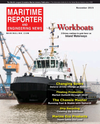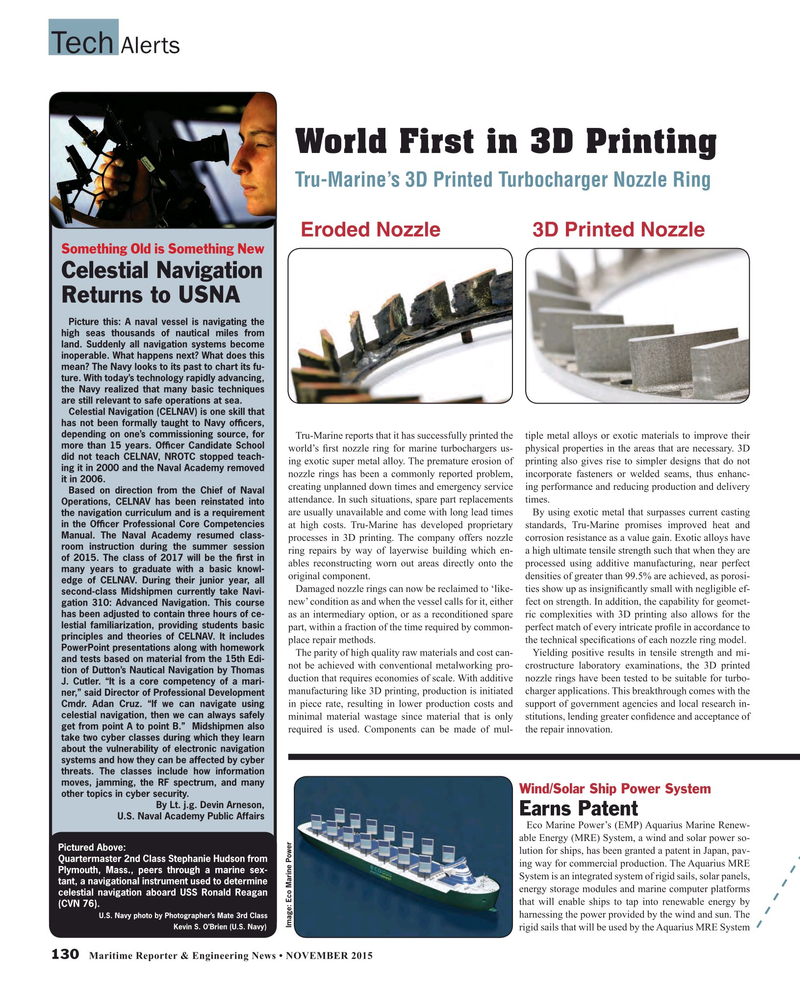
Page 130: of Maritime Reporter Magazine (November 2015)
Workboat Edition
Read this page in Pdf, Flash or Html5 edition of November 2015 Maritime Reporter Magazine
Tech Alerts
World First in 3D Printing
Tru-Marine’s 3D Printed Turbocharger Nozzle Ring
Eroded Nozzle3D Printed Nozzle
Something Old is Something New
Celestial Navigation
Returns to USNA
Picture this: A naval vessel is navigating the high seas thousands of nautical miles from land. Suddenly all navigation systems become inoperable. What happens next? What does this mean? The Navy looks to its past to chart its fu- ture. With today’s technology rapidly advancing, the Navy realized that many basic techniques are still relevant to safe operations at sea.
Celestial Navigation (CELNAV) is one skill that has not been formally taught to Navy of? cers, depending on one’s commissioning source, for
Tru-Marine reports that it has successfully printed the tiple metal alloys or exotic materials to improve their more than 15 years. Of? cer Candidate School world’s ? rst nozzle ring for marine turbochargers us- physical properties in the areas that are necessary. 3D did not teach CELNAV, NROTC stopped teach- ing exotic super metal alloy. The premature erosion of printing also gives rise to simpler designs that do not ing it in 2000 and the Naval Academy removed nozzle rings has been a commonly reported problem, incorporate fasteners or welded seams, thus enhanc- it in 2006.
creating unplanned down times and emergency service ing performance and reducing production and delivery
Based on direction from the Chief of Naval attendance. In such situations, spare part replacements times.
Operations, CELNAV has been reinstated into are usually unavailable and come with long lead times By using exotic metal that surpasses current casting the navigation curriculum and is a requirement in the Of? cer Professional Core Competencies at high costs. Tru-Marine has developed proprietary standards, Tru-Marine promises improved heat and
Manual. The Naval Academy resumed class- processes in 3D printing. The company offers nozzle corrosion resistance as a value gain. Exotic alloys have room instruction during the summer session ring repairs by way of layerwise building which en- a high ultimate tensile strength such that when they are of 2015. The class of 2017 will be the ? rst in ables reconstructing worn out areas directly onto the processed using additive manufacturing, near perfect many years to graduate with a basic knowl- original component. densities of greater than 99.5% are achieved, as porosi- edge of CELNAV. During their junior year, all
Damaged nozzle rings can now be reclaimed to ‘like- ties show up as insigni? cantly small with negligible ef- second-class Midshipmen currently take Navi- new’ condition as and when the vessel calls for it, either fect on strength. In addition, the capability for geomet- gation 310: Advanced Navigation. This course has been adjusted to contain three hours of ce- as an intermediary option, or as a reconditioned spare ric complexities with 3D printing also allows for the lestial familiarization, providing students basic part, within a fraction of the time required by common- perfect match of every intricate pro? le in accordance to principles and theories of CELNAV. It includes place repair methods. the technical speci? cations of each nozzle ring model.
PowerPoint presentations along with homework
The parity of high quality raw materials and cost can- Yielding positive results in tensile strength and mi- and tests based on material from the 15th Edi- not be achieved with conventional metalworking pro- crostructure laboratory examinations, the 3D printed tion of Dutton’s Nautical Navigation by Thomas duction that requires economies of scale. With additive nozzle rings have been tested to be suitable for turbo-
J. Cutler. “It is a core competency of a mari- manufacturing like 3D printing, production is initiated charger applications. This breakthrough comes with the ner,” said Director of Professional Development in piece rate, resulting in lower production costs and support of government agencies and local research in-
Cmdr. Adan Cruz. “If we can navigate using celestial navigation, then we can always safely minimal material wastage since material that is only stitutions, lending greater con? dence and acceptance of get from point A to point B.” Midshipmen also required is used. Components can be made of mul- the repair innovation. take two cyber classes during which they learn about the vulnerability of electronic navigation systems and how they can be affected by cyber threats. The classes include how information moves, jamming, the RF spectrum, and many
Wind/Solar Ship Power System other topics in cyber security.
By Lt. j.g. Devin Arneson,
Earns Patent
U.S. Naval Academy Public Affairs
Eco Marine Power’s (EMP) Aquarius Marine Renew- able Energy (MRE) System, a wind and solar power so-
Pictured Above: lution for ships, has been granted a patent in Japan, pav-
Quartermaster 2nd Class Stephanie Hudson from ing way for commercial production. The Aquarius MRE
Plymouth, Mass., peers through a marine sex-
System is an integrated system of rigid sails, solar panels, tant, a navigational instrument used to determine energy storage modules and marine computer platforms celestial navigation aboard USS Ronald Reagan that will enable ships to tap into renewable energy by (CVN 76). harnessing the power provided by the wind and sun. The
U.S. Navy photo by Photographer’s Mate 3rd Class
Image: Eco Marine Power
Kevin S. O’Brien (U.S. Navy) rigid sails that will be used by the Aquarius MRE System 130 Maritime Reporter & Engineering News • NOVEMBER 2015
MR #11 (130-137).indd 130 11/3/2015 11:09:09 AM

 129
129

 131
131
